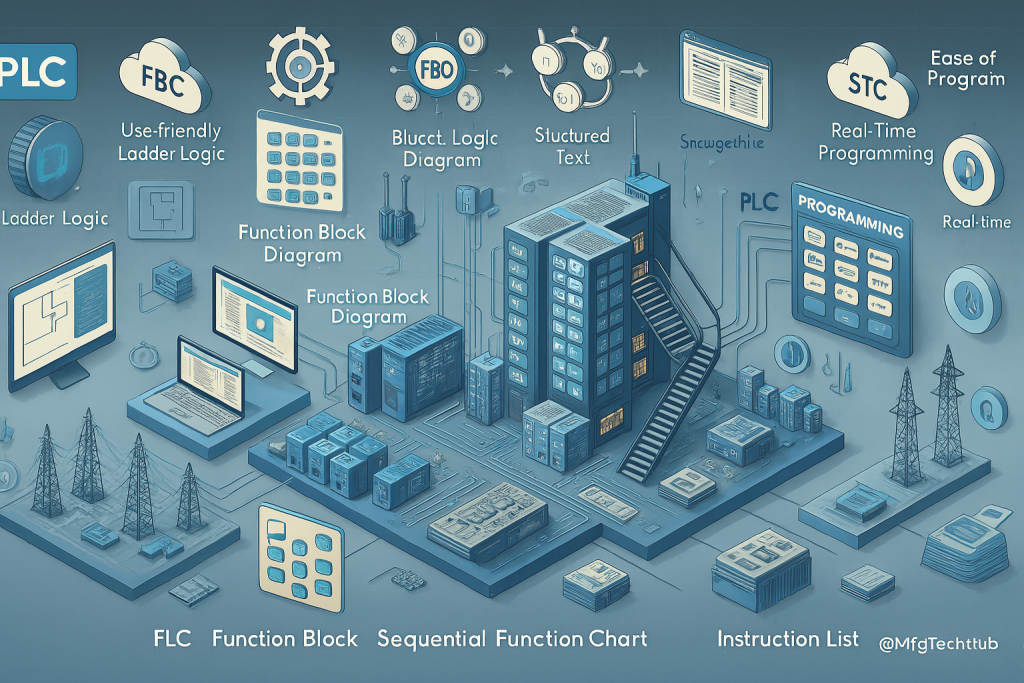Advantages of PLCs – Ease of Programming and Reprogramming
One of the biggest advantages of Programmable Logic Controllers (PLCs) is their ease of programming and reprogramming, making them versatile, adaptable, and user-friendly for industrial automation.

PLCs allow engineers to easily modify logic, troubleshoot errors, and optimize processes, reducing downtime and operational costs. Whether for a manufacturing plant, water treatment facility, or power plant, PLCs offer simple-to-use programming environments, intuitive debugging tools, and flexibility to adapt to new automation requirements.
This page explores why PLCs are easy to program, the different programming methods available, real-world benefits, and future trends in PLC programming.
1. Why Are PLCs Easy to Program?
Unlike traditional relay-based systems, which require manual wiring and hardware modifications, PLCs are programmed using software tools, making them more flexible and scalable.
- Graphical User Interface (GUI) – Drag-and-drop elements allow quick development and visualization.
- Modular & Structured Programming – Engineers can reuse code blocks, reducing errors.
- Multiple Programming Languages – Options for ladder logic, function blocks, structured text, and more.
- Live Monitoring & Debugging – Engineers can edit, troubleshoot, and test programs in real-time.
- Easy Updates & Modifications – Reprogramming PLCs requires only a few software adjustments.
Example: A food processing plant reprograms its PLC to change batch production sequences for different recipes. Instead of rewiring hardware, the engineer modifies the ladder logic in minutes, reducing downtime.
2. Popular PLC Programming Languages
The International Electrotechnical Commission (IEC) 61131-3 defines five standardized PLC programming languages, making PLCs easy to program and maintain.
A. Ladder Logic (LD) – Most Popular
- Graphical representation similar to relay logic.
- Easy for electricians and engineers to understand.
- Best for simple logic operations, sequential control, and motor starters.
Example: An automated conveyor belt system uses Ladder Logic to turn motors ON/OFF based on sensor inputs.
B. Function Block Diagram (FBD)
- Uses blocks representing logic functions.
- Best for complex control strategies like PID loops.
- Reusable and modular, reducing programming effort.
Example: A HVAC system uses FBD programming to adjust temperature based on real-time sensor data.
C. Structured Text (ST) – Advanced Programming
- Text-based programming like C or Python.
- Best for mathematical calculations, loops, and data handling.
- Used in advanced process automation.
Example: A chemical plant uses Structured Text to calculate fluid flow rates based on real-time pressure data.
D. Sequential Function Chart (SFC)
- Best for batch processing & step-by-step operations.
- Uses state transitions for clear visualization.
Example: A pharmaceutical factory automates pill production in stepwise operations, using SFC programming.
E. Instruction List (IL) – Least Common
- Low-level programming, similar to Assembly language.
- Best for simple, hardware-level instructions.
Example: A small embedded PLC system in automated vending machines uses IL for cost-effective logic execution.
3. Reprogramming PLCs: Quick & Efficient
Unlike fixed-control systems, PLCs can be modified easily without physical changes.
- Live Edits & Online Programming – Engineers can modify logic without stopping production.
- Firmware & Software Updates – PLCs can be upgraded without affecting existing programs.
- Parameter-Based Configurations – Operators can change values without modifying code.
- Remote Access & Cloud Programming – New PLCs allow remote troubleshooting and updates.
Example: A bottling plant adjusts fill levels for different bottle sizes without stopping production. The PLC automatically updates settings based on the new batch.
4. PLC Programming Tools & Software
Leading PLC manufacturers provide user-friendly programming software with drag-and-drop interfaces, debugging tools, and real-time monitoring.
| Manufacturer | Software | Features |
|---|---|---|
| Siemens | TIA Portal | Advanced simulation, multi-language support, live diagnostics. |
| Allen-Bradley | Studio 5000 | Ladder logic, FBD, ST programming, cloud integration. |
| Mitsubishi | GX Works3 | Structured programming, motion control, advanced security. |
| Schneider Electric | EcoStruxure | Remote monitoring, edge computing, advanced automation. |
| Omron | Sysmac Studio | AI integration, IoT connectivity, real-time process control. |
Example: A steel plant upgrades its Siemens PLCs using TIA Portal’s simulation tools to test new safety logic before deployment, ensuring zero downtime.
5. Industry Applications of Easy PLC Programming
- Manufacturing – Automates assembly lines, packaging, and robotic operations.
- Power Plants – Controls turbines, circuit breakers, and load balancing.
- Transportation – Manages traffic lights, railway signals, and metro systems.
- Building Automation – Controls HVAC, lighting, and security systems.
- Food & Beverage – Regulates processing, mixing, and packaging.
Example: A smart warehouse reprograms PLCs to optimize conveyor speeds based on demand, reducing energy costs by 15%.
6. Future Trends in PLC Programming
- AI & Machine Learning – PLCs will self-optimize processes based on real-time analytics.
- Cloud-Based PLC Programming – Engineers can program PLCs remotely from anywhere.
- No-Code & Low-Code Programming – Future PLCs will feature drag-and-drop automation tools.
- Wireless & Edge Computing – PLCs will process data locally for real-time decision-making.
- Cybersecurity in PLCs – Future PLC software will have built-in security protocols.
Example: A smart factory in Germany uses AI-driven PLCs that automatically adjust production rates based on demand, saving 20% in operational costs.
7. Benefits of Easy PLC Programming & Reprogramming
- Fast Deployment – New automation setups take hours instead of weeks.
- Reduced Maintenance Costs – Remote diagnostics reduce manual inspections.
- Scalability & Flexibility – Systems can be expanded easily without rewiring.
- Higher Productivity – PLCs adapt to real-time conditions without downtime.
- Error Reduction – Pre-programmed libraries and templates minimize programming mistakes.
Example: A car manufacturing plant reprograms its PLC overnight to accommodate a new vehicle model on the production line, avoiding weeks of delays.
The ease of programming and reprogramming makes PLCs the backbone of modern industrial automation. With user-friendly programming languages, real-time debugging, and remote access capabilities, PLCs allow industries to increase efficiency, reduce costs, and enhance flexibility.
Key Takeaways:
- PLCs use easy-to-learn graphical and textual languages.
- Programming software allows real-time editing and troubleshooting.
- AI, cloud, and IoT are the future of PLC programming.
